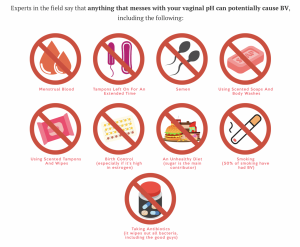Generally, I don’t think about my vagina too much, unless there’s a problem down yonder.
And I definitely don’t worry about its pH level, because until writing this, I didn’t even know vaginas had a pH level. I assumed it was like a self cleaning oven – you wash it in the shower and your vagina is spic and span, right?
Right-ish – most of the time, that’s the way our hoo-hahs work. But what happens when your vaginal pH is off-kilter?
Just because your pH balance is off doesn’t mean your cooter isn’t clean — let’s clear up that misconception right off the bat. If you notice a funky odor emanating from your lady parts, that’s the first sign your pH level could be off. “Your pH level (a.k.a., the acidity of the vaginal environment) has a lot to do with those mystery smells,” Lauren Streicher, M.D., Medical Director of the Northwestern Medicine Center for Sexual Medicine and Menopause tells Women’s Health.
So, what are normal vaginal pH levels?
“A normal vaginal pH is between 3.8 and 4.5. A pH level within this range can help to keep bacterial and fungal infections at bay,” according to Medical News Today. “Lactobacilli bacteria live in the vagina and secrete lactic acid and hydrogen peroxide, which give the vagina its acidic pH level.”
Vaginal pH changes during a woman’s lifetime.
“It is usually higher than 4.5 before a person has their first menstrual period and after menopause. Vaginal pH is usually less than 4.5 during a woman’s reproductive years, unless a condition or infection raises it.”
What changes vaginal pH?
Certain conditions and infections can affect the vaginal pH balance, usually by raising pH levels.
Causes of changes in vaginal pH consist of the following:
Bacterial vaginosis
The Mayo Clinic defines bacterial vaginosis as a “Type of vaginal inflammation caused by the overgrowth of bacteria naturally found in the vagina, which upsets the natural balance.
“Women in their reproductive years are most likely to get bacterial vaginosis, but it can affect women of any age. The cause isn’t completely understood, but certain activities, such as unprotected sex or frequent douching, increase your risk.”
Symptoms of bacterial vaginosis are itching, burning, or pain in the vagina. Some may also feel a burning sensation when urinating and experience a white or gray discharge.
Douching
Douching is the practice of washing or cleaning the vagina using specific solutions, such as over-the-counter products containing baking soda or vinegar.
“The practice of rinsing out your vagina with water or a cleansing agent (douching) upsets the natural balance of your vagina. This can lead to an overgrowth of anaerobic bacteria, and cause bacterial vaginosis. Since the vagina is self-cleaning, douching isn’t necessary,” Mayo Clinic says.
Menopause
A study done by Journal of Mid-Life Health found that women tend to have higher pH levels during menopause. In the study, women in menopause had an average vaginal pH of 5.3.
“Reduced estrogen levels during menopause may affect a person’s vaginal pH.”
Other Vaginal Infections
The presence of infections other than bacterial vaginosis may also increase the vaginal pH.
Examples include Trichomonas vaginalis and group B Streptococcus (GBS).
Presence Of Menstrual Blood
“Blood has a higher pH than the vaginal environment. When a person is menstruating, the presence of menstrual blood can increase vaginal pH levels,” says Medical News Today.
Taking Antibiotics
Antibiotics are used to kill harmful bacteria, but they can kill good bacteria as well, including bacteria in the vagina. If someone is taking antibiotics, their vaginal pH may be thrown out of balance.
Urinary Tract Infections (UTIs)
“UTIs do not cause a higher vaginal pH, but having a high pH can increase a person’s risk of developing a UTI,” says Medical News Today.
“Reduced estrogen levels during perimenopause and menopause can put a person at risk of developing more frequent UTIs, as lower estrogen allows the vaginal pH to rise.”
Doctors can prescribe estrogen treatments to lower vaginal pH and to help prevent further UTIs.
How To Treat
If a person’s vaginal pH levels are commonly high with no presence of an infection, they can take measures at home to reduce their pH levels. Medical News Today says these include:
-
Avoiding harsh soaps and douching. Soaps typically have a high pH, and using them to clean the vaginal area may increase vaginal pH. It is best to use warm water and a gentle cleanser to clean the vulva but to refrain from using soap inside the vagina. This will help to maintain the vaginal pH balance.
-
Taking a probiotic supplement or suppository. Probiotics help to restore the body’s natural bacterial levels. Some foods also contain probiotics, including yogurt, miso, and kombucha.
-
Changing tampons regularly. Leaving a tampon in for too long can increase the vaginal pH because the pH of blood is slightly basic. Changing tampons frequently also reduces the risk of bacterial infections, including toxic shock syndrome (TSS).
-
Using barrier protection during sex. Barrier protection, such as condoms or dental dams, not only helps to prevent pregnancy and STIs but can prevent semen and other fluids from affecting pH levels in the vagina.
Doctors can also prescribe creams, such as estrogen cream, which may help to reduce the vagina’s pH levels. Always talk to your doctor or OB/GYN before trying any at-home remedies.

Did you know these things could affect your vaginal pH balance? Share with us in the comments!
Want More Health And Wellness Articles? Keep Scrolling To Read On:


